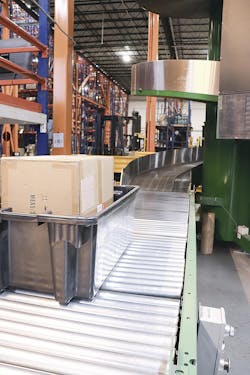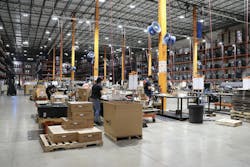MENTOR, Ohio—Speaking with Buyers Products representatives after a tour of the company’s new 280,000 sq.-ft., 67-ft. high, state-of-the-art warehouse space, a theme emerges: speed.
“We’ve always been quick, and that’s one thing we’ve always stressed with our customers. With the new technology—with the UPS conveyors, with the pickers, the different kind of things that we invested in—it just helps,” said Paul Williams, creative services manager for Buyers. “As our product line continues to grow, it helps to get that out the door faster for the customers, where we rely less on human picking and more on the automated process, and it just helps tighten everything that we do.”
And speed has become paramount in a world where consumers have become accustomed to the near-instant gratification of online shopping and next-day delivery.
Indeed, Amazon is “a great channel,” but just one of several for Buyers Products. The company’s “number one effort” remains the relationship with Buyers distributors, explained Joe Gondek, director of marketing and communications.
“We live in a world where Amazon is an additive, versus it being a competition. Certainly, there’s going to be overlap on our offerings with our distributors, but a lot of the opportunities for retail and for small volumes, our ability to get things out the door plays very nicely with Amazon’s model of getting things to people quickly,” Gondek said. “We have national accounts with Home Depot and Lowe’s and others. All of that data and our sophistication, from an IT perspective, allows us to be more efficient.”
Slow is smooth, smooth is fast
Speed, of course, doesn’t come quickly. As it approaches its 80th anniversary, Buyers Products is an exemplar for American manufacturing achievement, family ownership, and strategic diversification.
The company, now into the third generation, has grown from a single building into a sprawling campus of over a million square feet, dominating the snow and ice equipment sector while offering a vast catalog of truck accessories that serve everyone from homeowners to massive municipal fleets.
With such an array of products, built to fit a range of vehicles, there are lots of moving parts to designing, manufacturing, and distributing all those parts.
“We have a very robust IT department that’s really helping us with the product managers, the marketing team, the engineers, because there are a lot of things that change on a daily basis,” Gondek said. “We’re constantly adding things, and so there is a lot of data and logic that is going on behind the scenes that really make us successful.”
The automated systems read orders, determine the optimal path through the warehouse, and route packages to the correct shipping bays, minimizing human error and maximizing speed.
This investment in logistics has transformed operations, moving from a time when truck drivers might have had to help pick their own orders to a streamlined system where shipments are staged and ready at one of the approximately 60 docks, ensuring trucks can load and depart with minimal delay.
Again, the culture at Buyers is the foundation this is built on.
“One of the nice things about a family-owned company is there’s lots of interdepartmental communications going on,” Lucas Sigurdson, digital marketing lead, said. “We work really closely with sales, and we work really closely with product management. We’re all working together to make good decisions.”
That teamwork, rooted in the organization’s “longevity and experience,” is an essential element of speed, Gondek continued.
“We’re able to move resources, to follow the ball, and put them there,” he said. “If we do have an upturn in toolboxes, we can move people there. If, all of a sudden there’s going to be nor’easters, we can move people back over to snow and ice. And so it really just comes back to data.”
Gondek points to rushing products to Atlanta for an unexpected snow event, knowing that it would be short-lived, as the sort of flexibility Buyers is positioned to support. And the broad product line means those Atlanta customers are already familiar with the company through toolboxes, for instance, and can get on the phone when ice is in the forecast. Likewise, during a dry Chicago winter, the Buyers catalog offers solutions.
This diversification ensures operational continuity and job security for employees.
“Certainly anytime you have a larger, private company that’s going to be invested in the people, and you have a lot of advantages,” Gondek said. “You’re not playing to the whims of your stock, your shareholders, and everything else. So we can make longer-term planning decisions. We’re able to weather—no pun intended—things better than other companies because of being a private organization.
“We can play the long game, and not all the competition can do that. They get pressures from private equity or shareholders and have to make those compromises where we don’t. And being around 80 years, that consistency of quality, of the values that we have, are all in place.”
Product innovation
In an industry where products are constantly battered by the elements—particularly the corrosive duo of salt and moisture—innovation in materials and manufacturing is paramount.
Buyers has been at the forefront of this evolution. Recognizing the limitations of traditional steel, the engineering team was instrumental in developing and popularizing poly spreaders.
These rotationally molded plastic hoppers, produced at their RomoTech facility in Indiana, resist corrosion and have become a market standard, largely replacing their steel predecessors.
“As that evolves, we’re major players in that space because we have the materials available, or we took the time to develop those,” Gondek said.
Where metal is necessary, the company has championed the use of higher-quality materials.
This commitment to quality extends to their manufacturing processes. Buyers has heavily invested in robotic welding and cobots (collaborative robots), which work alongside their skilled human welders.
This blend of automation and human expertise results in cleaner, stronger, and more durable welds on products like their truck toolboxes, a critical factor as the demand for mobile maintenance vehicles has exploded.
The finished products not only perform better but also have a superior aesthetic, free from the burn marks seen on some competing products
Made in the USA
Made in the USA has long been a point of pride for the organization, and it is now paying off more than ever.
“We’re getting a lot more calls as companies are having to make some dramatic changes to their supply chain,” Gondek said. “So we are sitting in an advantageous place.”
But there’s some uncertainty as to how the ongoing international trade negotiations work themselves out.
Tariffs are a “moving target” but, again, “longevity, consistency” has Buyers well positioned.
“We’re going to have some cost and price changes, but we’re not going to be fluctuating as dramatically behind the scenes. Some of our competitors are going to have to eat a lot of dollars internally to stay competitive,” Gondek said. “That’s the overall challenge in some of these companies with the tariffs now: Are they going to place it on the customers, or are they going to eat into their own margins? I think a lot of it’s going to come back to what inventories they’re sitting on, and then what the weather is going to to look like.”
Remaining the lead ‘Dogg’
Turns out, a company can build up positive momentum—speed—over eight decades.
“The biggest challenge is continuing to evolve your offerings. You don’t forsake the ones that you’ve done in the past,” Gondek said. “Our aftermarket business continues to thrive. We have a lot of different pieces and components that we need to stay on top of, just to support existing products.
“And, as any company that continues to grow, we have all the logistics challenges that come with that. We have more customers, we have more products and offerings, and so with that comes a lot of different increased logistics infrastructure needs, investments in the technology, but also all the internal workings for our IT team to be able to continue to maintain all that data. Then, certainly, the more information that we get we want to be more predictive about the offerings that are yet to come.”
More SKUs for Buyers Products? Say it ain’t so, Joe.
Williams recalled sitting at a red light with his son, once again pointing out all of the Buyers equipment on various trucks at the intersection. “Aw, Dad, come on.”
About the Author
John Hitch
Editor-in-chief, Fleet Maintenance, Senior Editor, Trailer-Body Builders
John Hitch is the editor-in-chief of Fleet Maintenance, where his mission is to provide maintenance management and technicians with the the latest information on the tools and strategies to keep their fleets' commercial vehicles moving.
He is based out of Cleveland, Ohio, and has worked in the B2B journalism space for more than a decade.
Hitch was previously senior editor for FleetOwner, and covers everything related to trucking and commercial vehicle equipment, including breaking news, the latest trends and best practices. He previously wrote about manufacturing and advanced technology for IndustryWeek and New Equipment Digest.
Prior to that he was editor for Kent State University's student magazine, The Burr, and a freelancer for Cleveland Magazine. He is an award-winning journalist and former sonar technician, where he served honorably aboard the fast-attack submarine USS Oklahoma City (SSN-723).



